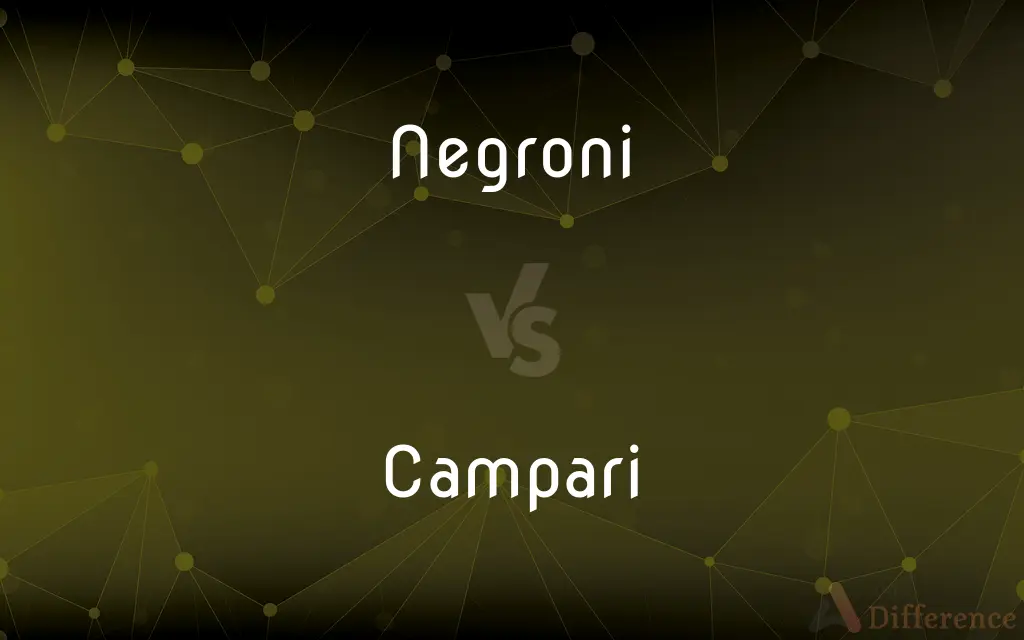Negroni vs. Campari — What's the Difference?
By Fiza Rafique & Urooj Arif — Updated on April 2, 2024
Negroni is a classic cocktail blending gin, vermouth, and Campari in equal parts, offering a balance of bitterness and sweetness. Campari, on the other hand, is a key ingredient in Negroni, known for its distinctive bitter flavor and vibrant red color.

Difference Between Negroni and Campari
Table of Contents
ADVERTISEMENT
Key Differences
Negroni is a well-loved cocktail that combines gin, sweet vermouth, and Campari in equal measures, creating a harmonious balance between sweetness and bitterness. Whereas Campari is a bitter Italian liqueur, characterized by its dark red color and is used in various cocktails, including the Negroni.
The creation of Negroni dates back to the early 20th century in Italy, attributed to Count Camillo Negroni who asked for a stronger version of the Americano cocktail. On the other hand, Campari was created earlier, in the mid-19th century by Gaspare Campari in Milan, and quickly became popular for its unique taste.
Negroni is served over ice, typically garnished with an orange peel to accentuate its citrusy notes. Campari, however, is versatile in its consumption, enjoyed either on its own, with soda, or as a part of various cocktails, not just limited to the Negroni.
The flavor profile of a Negroni is complex; the bitterness of Campari is balanced by the sweetness of the vermouth and the botanicals of the gin. In contrast, Campari itself offers a straightforward yet intense bitter flavor, with hints of herbs and fruit.
Both Negroni and Campari play significant roles in the world of cocktails, but while the Negroni is celebrated for its balanced complexity, Campari stands out as a bold, singular taste that defines not only the Negroni but many other mixed drinks as well.
ADVERTISEMENT
Comparison Chart
Category
Cocktail
Liqueur
Main Ingredients
Gin, sweet vermouth, Campari
Alcohol, water, sugar, bitter herbs, fruit
Origin
Italy, early 20th century
Italy, 1860
Serving
Over ice, garnished with an orange peel
On its own, with soda, or in cocktails
Flavor
Balanced sweet and bitter, with citrus notes
Intensely bitter, with herbal and fruit notes
Compare with Definitions
Negroni
A cocktail combining gin, sweet vermouth, and Campari.
I enjoyed a refreshing Negroni at the cocktail bar last night.
Campari
Can be enjoyed on its own or mixed in drinks.
Some prefer Campari with soda, while others enjoy it in a Negroni.
Negroni
Celebrated for its complexity and depth.
Aficionados appreciate the Negroni for its complex flavor profile.
Campari
Integral to many cocktail recipes beyond the Negroni.
Campari is versatile, featuring in many cocktails besides the Negroni.
Negroni
Served over ice, usually garnished with an orange peel.
The bartender presented the Negroni over ice with a beautiful orange twist.
Campari
Created in the mid-19th century by Gaspare Campari.
Campari has been a staple in Italian bars since the 1860s.
Negroni
Originated in Italy as a stronger version of the Americano.
The Negroni's history dates back to Italy in the early 20th century.
Campari
Known for its distinctive red color and bitter taste.
Campari's vibrant red hue and bitter flavor make it unforgettable.
Negroni
Known for its balance of bitterness and sweetness.
The perfect Negroni strikes a fine balance between sweet and bitter flavors.
Campari
A bitter Italian liqueur used in various cocktails.
I added Campari to my cocktail for a touch of bitterness.
Negroni
The Negroni is a popular Italian cocktail, made of one part gin, one part vermouth rosso (red, semi-sweet), and one part Campari, garnished with orange peel. It is considered an apéritif.
Campari
Campari (Italian: [kamˈpaːri]) is an Italian alcoholic liqueur, considered an apéritif (20.5%, 21%, 24%, 25%, or 28.5% ABV, depending on the country in which it is sold), obtained from the infusion of herbs and fruit (including chinotto and cascarilla) in alcohol and water. It is a bitters, characterised by its dark red colour.
Negroni
A cocktail made of gin, sweet vermouth, and bitters, often garnished with a lemon or orange peel.
Negroni
A cocktail consisting of gin, Campari and vermouth.
Common Curiosities
How do you serve a Negroni?
A Negroni is served over ice, typically garnished with an orange peel.
What is Campari?
Campari is a bitter Italian liqueur known for its dark red color and unique taste.
Can I substitute another liquor for gin in a Negroni?
While traditional Negronis use gin, some variations substitute it with other spirits, such as whiskey for a Boulevardier.
What are the best occasions to drink a Negroni?
Negronis are versatile and can be enjoyed as an aperitif or during cocktail hour.
What’s the difference between a Negroni and an Americano?
A Negroni contains gin instead of soda water, making it stronger than an Americano, which is made with Campari, sweet vermouth, and soda water.
Can Campari be drunk on its own?
Yes, Campari can be enjoyed on its own, with soda, or as part of cocktails like the Negroni.
What is a Negroni made of?
A Negroni is made of equal parts gin, sweet vermouth, and Campari.
Do you need special ingredients for a Negroni?
A Negroni requires gin, sweet vermouth, and Campari, which are readily available in most liquor stores.
What does a Negroni taste like?
A Negroni tastes like a balanced mix of sweet and bitter, with citrus notes from the orange garnish.
Can you make a non-alcoholic version of a Negroni?
Yes, a non-alcoholic version can be made using non-alcoholic substitutes for gin, vermouth, and Campari.
What makes Campari unique?
Campari's unique taste comes from its blend of herbs, fruit, alcohol, and water.
Is a Negroni strong?
Yes, a Negroni is considered a strong cocktail due to its alcohol content from gin and Campari.
How should Campari be stored?
Campari should be stored in a cool, dark place, similar to other spirits.
Is Campari good for digestion?
Campari is often considered a digestif, with its bitter qualities believed to aid digestion.
How has the popularity of Negroni evolved?
The popularity of the Negroni has grown significantly, becoming a staple in bars worldwide and celebrated annually on Negroni Week.
Share Your Discovery

Previous Comparison
Lap vs. Lop
Next Comparison
Connoisseur vs. SommelierAuthor Spotlight
Written by
Fiza RafiqueFiza Rafique is a skilled content writer at AskDifference.com, where she meticulously refines and enhances written pieces. Drawing from her vast editorial expertise, Fiza ensures clarity, accuracy, and precision in every article. Passionate about language, she continually seeks to elevate the quality of content for readers worldwide.
Co-written by
Urooj ArifUrooj is a skilled content writer at Ask Difference, known for her exceptional ability to simplify complex topics into engaging and informative content. With a passion for research and a flair for clear, concise writing, she consistently delivers articles that resonate with our diverse audience.













































